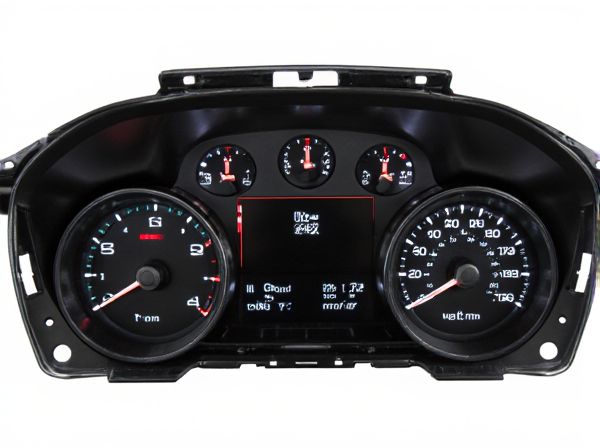
Photo illustration: Retrofit Cluster vs OEM Cluster
Retrofit clusters offer a customizable and often more affordable alternative to OEM clusters, allowing you to upgrade or replace your vehicle's instrument panel without purchasing original manufacturer parts. OEM clusters provide guaranteed compatibility and factory-level quality, ensuring seamless integration with your vehicle's systems and existing features. Choosing between retrofit and OEM clusters depends on your budget, desired functionality, and the importance of maintaining original factory specifications.
Table of Comparison
| Feature | Retrofit Cluster | OEM Cluster |
|---|---|---|
| Compatibility | Universal fit for multiple car models | Designed specifically for one vehicle model |
| Installation | Easy plug-and-play installation | Factory-installed during vehicle assembly |
| Functionality | Basic to advanced features depending on model | Full integration with vehicle systems and sensors |
| Display Quality | Standard LCD or OLED screen options | High-resolution, manufacturer-optimized displays |
| Software Updates | Limited or manual updates | Seamless over-the-air updates |
| Price | Cost-effective alternative | Higher cost, included in vehicle price |
| Warranty | Aftermarket warranty coverage | Full manufacturer warranty |
Understanding Retrofit Clusters and OEM Clusters
Retrofit clusters are aftermarket instrument panels designed to replace or upgrade existing vehicle dashboards, offering enhanced functionality and modern digital displays without the need for a full vehicle redesign. OEM clusters, produced by original equipment manufacturers, are factory-installed and specifically engineered to integrate seamlessly with the vehicle's electrical systems and software for optimal performance and accuracy. Understanding the differences involves recognizing that retrofit clusters provide customizable solutions and compatibility with multiple vehicle models, while OEM clusters ensure manufacturer-grade reliability and direct system integration.
Key Differences Between Retrofit and OEM Clusters
Retrofit clusters are aftermarket digital instrument panels designed to replace or upgrade existing analog or outdated OEM clusters, offering enhanced customization and modern features such as advanced diagnostics and connectivity. OEM clusters are factory-installed, specifically calibrated for vehicle systems and integrated with manufacturer software to ensure seamless compatibility and reliability. Key differences include retrofit clusters' flexibility in design and functionality versus OEM clusters' precision in vehicle-specific integration and original equipment compliance.
Performance Comparison: Retrofit vs OEM Clusters
Retrofit clusters typically offer enhanced customization and can be optimized for specific vehicle requirements, resulting in potentially better performance in targeted applications compared to OEM clusters. OEM clusters benefit from seamless integration and factory-level calibration, ensuring consistent performance, reliability, and compatibility with the vehicle's original systems. Performance comparison reveals retrofit clusters may excel in flexibility and feature updates, while OEM clusters maintain superior stability and standardization.
Cost Considerations: Retrofit vs OEM Clusters
Retrofit clusters typically offer a cost-effective solution by upgrading existing infrastructure, minimizing expenses related to new hardware and installation. OEM clusters often involve higher upfront costs due to proprietary components and comprehensive warranties but provide integrated performance and vendor support. Evaluating the total cost of ownership, including maintenance and compatibility, is essential when choosing between retrofit and OEM clusters.
Installation Process: Retrofit and OEM Clusters Explained
Retrofit clusters require custom installation tailored to existing vehicle wiring and dashboard configurations, often involving additional adapters or programming to integrate seamlessly with older systems. OEM clusters are factory-installed and engineered for plug-and-play installation, ensuring compatibility with original vehicle sensors and electronic control units (ECUs). The retrofit installation process tends to be more complex and time-consuming, whereas OEM clusters offer streamlined integration and minimized installation errors.
Compatibility and Integration Issues
Retrofit clusters often face compatibility challenges with existing vehicle electronics, requiring intricate calibration to ensure seamless integration with original sensors and CAN bus systems. OEM clusters are designed specifically for their vehicle models, guaranteeing plug-and-play compatibility and full integration with onboard diagnostics and infotainment controls. Improper integration of retrofit clusters can lead to inaccurate speedometer readings, malfunctioning warning lights, and communication errors within the vehicle network.
Customization Options in Retrofit vs OEM Clusters
Retrofit clusters offer extensive customization options, allowing users to select specific gauges, display layouts, and advanced features tailored to individual vehicle preferences, often through modular designs and software updates. OEM clusters typically provide limited customization, constrained by factory configurations and standardized interfaces to ensure consistency and warranty compliance. The flexibility in retrofit clusters enables integration of aftermarket sensors and personalized visual themes, which OEM clusters rarely support.
Maintenance and Support: What to Expect
Retrofit clusters generally require specialized maintenance and support due to their customized integration with existing vehicle systems, often demanding expert technicians familiar with the retrofit brand and installation specifics. OEM clusters offer standardized support and maintenance services backed by the vehicle manufacturer, ensuring compatibility and access to original parts and software updates. Expect retrofit clusters to have varied support quality depending on the vendor, while OEM clusters provide consistent, manufacturer-approved maintenance protocols.
Pros and Cons of Retrofit Clusters
Retrofit clusters offer flexibility by enabling modern features like customizable displays and enhanced connectivity without fully replacing the OEM dashboard, which minimizes cost and installation complexity. However, retrofit clusters may face compatibility issues with some vehicle systems, leading to potential integration challenges and limited access to certain OEM-specific functionalities. Choosing retrofit clusters balances upgrade benefits and affordability but requires careful evaluation of vehicle model compatibility and desired feature sets.
Pros and Cons of OEM Clusters
OEM clusters offer seamless integration with the vehicle's existing systems, ensuring accurate diagnostics and compatibility with manufacturer-specific features. They typically provide better support and updates tailored to each vehicle model, enhancing reliability and user experience. However, OEM clusters are often more expensive and less flexible than retrofit clusters, limiting customization options and aftermarket modifications.
 caratoz.com
caratoz.com